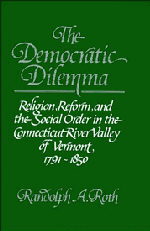 The Democratic Dilemma
The Democratic Dilemma Book contents
- Frontmatter
- Contents
- List of tables and maps
- Acknowledgments
- Introduction
- 1 The revolutionary frontier, 1763–1800
- 2 The failure of the covenanted community and the standing order, 1791–1815
- 3 Religion and reform in the shaping of a new order, 1815–1828
- 4 From an era of promise to pressing times, 1815–1843
- 5 A clamor for reform, 1828–1835
- 6 The great revival, 1827–1843
- 7 A modified order in town life and politics, 1835–1850
- 8 Boosterism, sentiment, free soil, and the preservation of a Christian, reformed republic
- Conclusion: Religion, reform, and the problem of order in the Age of Democratic Revolution
- Appendix A Church records
- Appendix B Types of towns
- Appendix C Occupational groups
- Appendix D Statistical methods
- Notes
- Index
2 - The failure of the covenanted community and the standing order, 1791–1815
Published online by Cambridge University Press: 04 August 2010
- Frontmatter
- Contents
- List of tables and maps
- Acknowledgments
- Introduction
- 1 The revolutionary frontier, 1763–1800
- 2 The failure of the covenanted community and the standing order, 1791–1815
- 3 Religion and reform in the shaping of a new order, 1815–1828
- 4 From an era of promise to pressing times, 1815–1843
- 5 A clamor for reform, 1828–1835
- 6 The great revival, 1827–1843
- 7 A modified order in town life and politics, 1835–1850
- 8 Boosterism, sentiment, free soil, and the preservation of a Christian, reformed republic
- Conclusion: Religion, reform, and the problem of order in the Age of Democratic Revolution
- Appendix A Church records
- Appendix B Types of towns
- Appendix C Occupational groups
- Appendix D Statistical methods
- Notes
- Index
Summary
In the years following statehood, settlers who wanted to reconcile their conflicting ambitions through the ideals and institutions of the covenanted community and the standing order met with nothing but frustration. Defenders of the covenanted community confronted an influx of settlers from southern New England who were less committed to the ideals of evangelical Calvinism than settlers in the past. They also had to deal with the effects of the Revolution's liberating ideas and the dangers presented by plentiful economic opportunities, which made the valley's residents unwilling to abide by the sanctions and strictures of the covenant. Calvinists could no longer discipline those who were not church members, and even church members rebelled against the watch and care of the church. Young people presented a serious problem, as did the trend toward sectarianism.
Maintaining the standing order proved equally difficult. Even the relatively mild legal and institutional supports that had been erected in its defense came under attack, and the unity, tolerance, calm, and deference that was vital to its success began to evaporate. Political leaders faced growing opposition within the valley. They fell to bickering among themselves, and joined in a party struggle that destroyed their hopes of harmony. By 1815 both the covenanted community and the standing order were in ruins. Friend and foe alike were left to wonder what ideals and institutions could replace them.
Ungovernable townspeople and church members
In 1779, the assembly of the newly formed Republic of Vermont had heartened the defenders of the covenanted ideal and the standing order by passing a body of laws for the preservation of public morals.
- Type
- Chapter
- Information
- The Democratic DilemmaReligion, Reform, and the Social Order in the Connecticut River Valley of Vermont, 1791–1850, pp. 41 - 79Publisher: Cambridge University PressPrint publication year: 1987


